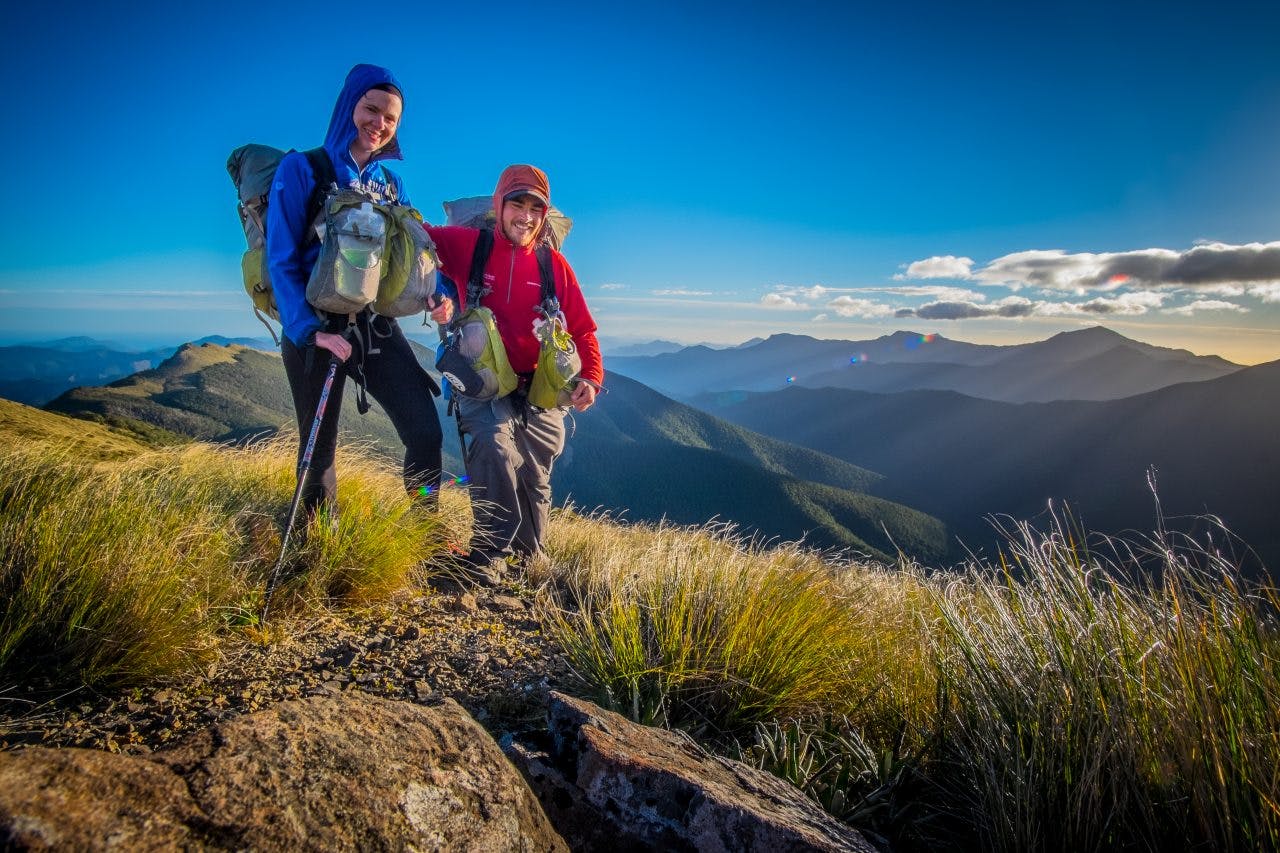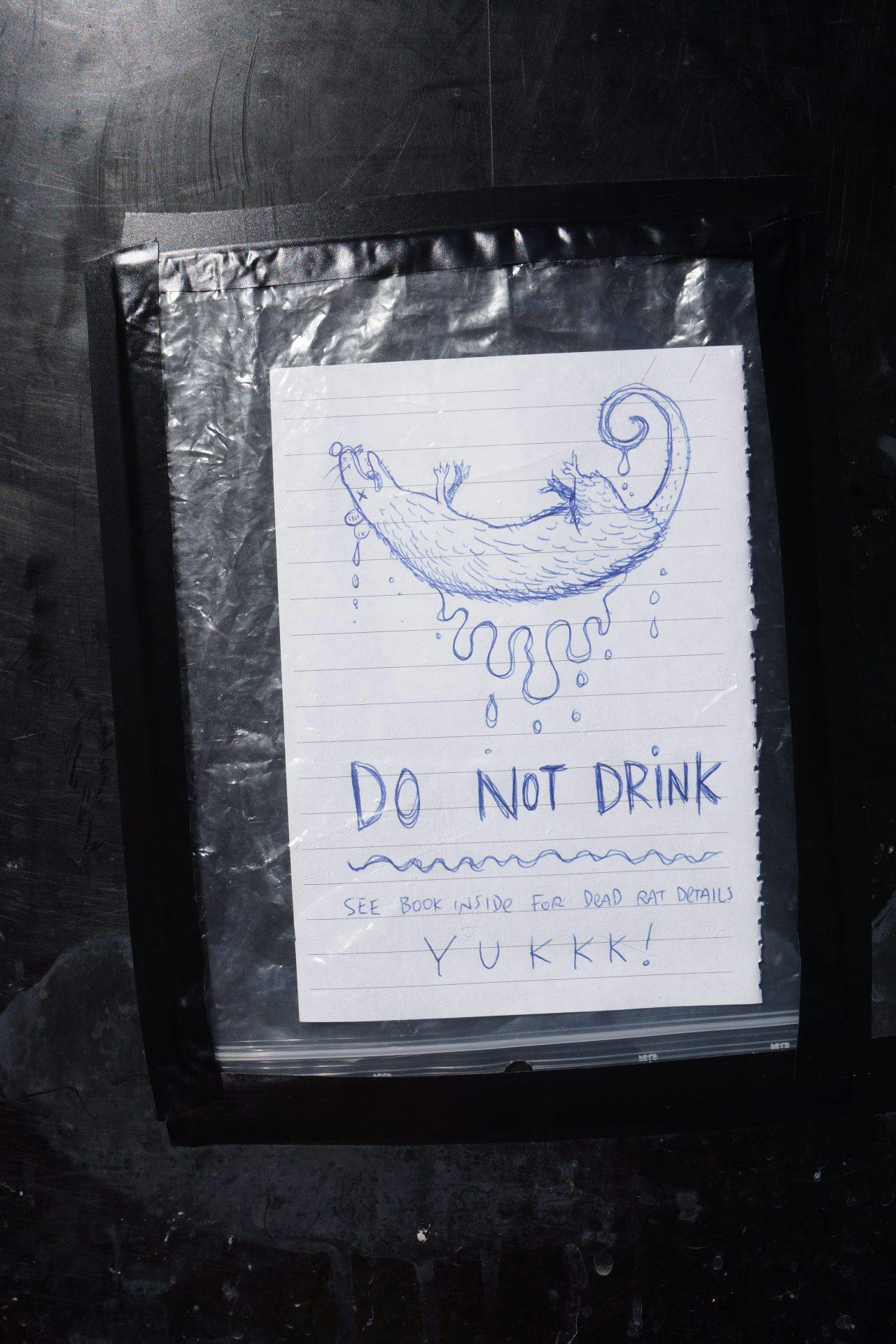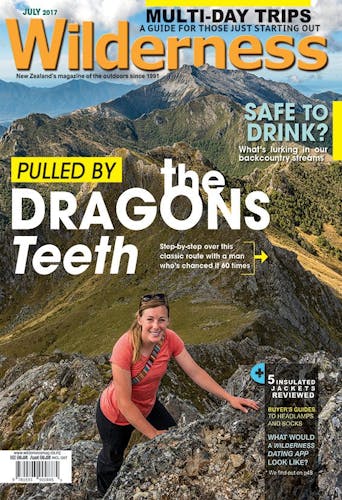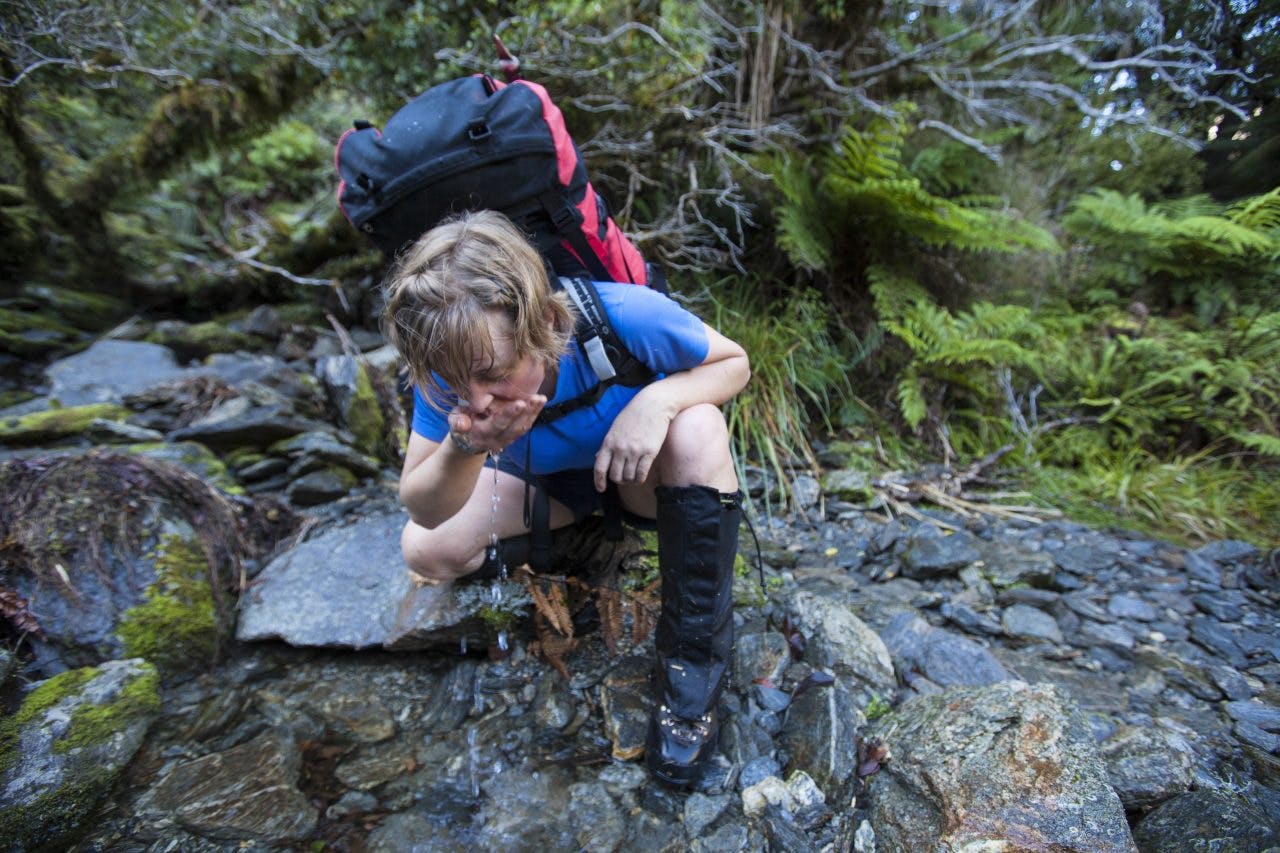New Zealand seems to be one of the few places in the world where water can still be drunk straight out of backcountry streams, free from worry. Or can it?
Halfway up Mt Ngauruhoe, Irishman Alan Moore knew he had a problem.
It was 2014, and for the previous few months he’d been thru-hiking the Te Araroa Trail with his girlfriend, but had taken a detour after completing the Whanganui River Journey to walk the Tongariro Alpine Crossing.
As he made his way amongst the throngs of tourists, he brushed off his nausea, blaming it on the drinks he’d had the night before.
“The clouds came in and I couldn’t see 10m above or below me,” Moore recalls. “They also clouded my judgement, as the onset of lightheadedness didn’t send me back down the mountain.”
He carried on, assuming it was probably a bit of altitude sickness on top of a little hangover, and that it would probably wear off soon.
“One feeling I’ll never forget was the stench of sulphur burning my nostrils while stomach cramps burned my insides. I was exhausted,” Moore says. When he was passed by “little old tourists” on the short ascent to Blue Lake, it was clear to him that his condition was more than a hangover.
It was over the Christmas holidays, so he had to wait a few days to see a doctor. “Weak as a wet paper bag,” he was finally seen on his return to Whanganui, where the doctor confirmed he was suffering the effects of a water parasite and gave him antibiotics for giardia.
Both Moore and the doctor surmised he had picked it up on the Whanganui River. Moore was the only unlucky one of his group; his two partners on the canoe journey were symptom-free, but Moore was out for another week while he recovered.
Moore was one of 1709 people who contracted giardiasis in 2014; New Zealand has the highest rate of giardia in the developed world. While most cases are from urban water supplies, research scientist Elaine Moriarty from the Institute of Environmental Science and Research Limited (ESR) says trampers should be concerned – even in the backcountry.
“There could be faecal contamination coming from birds, or possums, or wild pigs, or any number of sources that you’re not aware of. But just because you can’t see it and it’s not near a town doesn’t mean there aren’t faecal sources nearby,” Moriarty says.
Also, she says you can’t tell if water is contaminated just by looking at it. That sparkling clear waterfall could have giardia flowing through it.
“You never know by looking at water if there’s bugs in it or not. You don’t know what’s happened upstream,” she says.
The two major forms of water contamination are from giardia and Escherichia coli (E.coli). Giardiasis is caused by the parasite Giardia lamblia found in the gut of infected humans and animals such as cattle, sheep, cats, dogs, rats and possums. In the US, it’s often called ‘Beaver Fever’, because it’s commonly thought of as a camping or tramping related disease.
Moriarty says giardia is persistent; it survives really well in the environment.
It’s not uncommon for giardia to go undiagnosed; that’s partly because of its incubation period. It can take one to three weeks for symptoms to appear, and Moriarty says that oftentimes, people associate the symptoms with something they’ve eaten.
“People are more likely to blame food that they’ve had, such as the burger they had when they finished their tramp, as opposed to the water they drank on the tramp. Or even the barbecue they had a week later.”
Symptoms can include diarrhoea, gas, stomach or abdominal cramps, nausea, and dehydration. However, some people who contract giardia show no symptoms at all. Typically, symptoms could last from two to six weeks; medications can decrease that time.
According to the Ministry of Health, there were 1616 cases of giardia recorded in New Zealand in 2016. The highest rates are from the central North Island; Rotorua and Taupo lakes regions. Of those 1616, 41 people consumed water from a non-residential untreated water supply or had recreational water contact.

Alan Moore, right, was laid low for more than a week by giardiasis contracted on the Whanganui River. Photo: Supplied
E.coli is another bug that could be lurking in your backcountry water source. The bacteria is most often found in sewage, stormwater runoff and animal waste. Higher levels are found in pastoral streams, but even pristine-looking streams could contain E.coli from bird and animal faeces.
Symptoms of E.coli infections are similar to giardiasis; severe stomach cramps, diarrhoea and vomiting are common. Recovery is typically five to seven days.
Rivers in animal grazing areas are the most risky. “The biggest contributing factor in the backcountry depends on the land use around it; if there are animals grazing around it such as sheep and goats and pigs,” Moriarty says.
There’s also concerns around dead animals in water sources. When I mentioned that I’d recently seen a dead possum at the edge of a river, she said it was lucky I’d seen it. Indeed, I’d been tempted to fill my water bottle just before seeing the decomposing pest.
‘Out of sight, out of mind’ can be a tramper’s downfall.
Many Kiwi trampers won’t bat an eye at scooping up a bottle full of river water on a backcountry tramp. But Dr Rob Davies-Colley, principal scientist in water quality with the National Institute of Water and Atmospheric Research (NIWA), says unless you boil, filter or purify, it’s always a gamble.
“Water quality is very good on average in the conservation estate, but even in apparently pristine catchments water quality can be relatively poor under high state-of-flow conditions,” Davies-Colley says. In such catchments there are still mammal pests that can carry diseases such as giardia and Campylobacter – which are far more likely to be present in river water at high state-of-flow.
A quickly flowing stream may seem like a great place to collect water. However, Davies-Colley says the opposite is true.
The concentration of E.coli bacteria, indicating faecal pollution, can vary widely depending on the river’s state-of-flow rate; E.coli is usually at its highest when the water level is rising rapidly after recent rainfall. Davies-Colley says this is because the accelerating currents disturb river bed sediments which can contain faecal microbes, including pathogens. Additionally, heavy rainfall temporarily floods areas of land containing faecal matter, thus washing in harmful microbes.
“Faecal microbes tend to travel in river waters together with other fine particulate material, such as clay particles, silt, and fine organic material, which causes water to appear cloudy and reduces visual clarity. So if river water is visually clear, it is probably very low in faecal pollution and safe to drink.”
Clear lake water is an even safer option, because the surface water’s exposure to sunlight – in particular ultraviolet wavelengths – can kill off faecal microbes such as E.coli. Davies-Colley says hard-to-kill protozoan cysts such as giardia typically settle in the sediment bed, beyond the reach of UV light. His advice: collect water at the surface of a clear lake, far from a river inlet.
“I’m a keen tramper myself, and have often drunk water, untreated, from backcountry rivers and lakes despite the tolerably small risk of microbial contamination of such waters – at least under dry conditions,” Davies-Colley says. He says he’s always careful not to disturb bottom sediments when collecting water, and relies on visual water clarity and recent weather as indicators to the level of risk.
“The best indicator of state-of-flow is the level of the water in the river channel compared to vegetation on the banks that cannot grow where they are constantly submerged,” he explains. “When the water level encroaches on this terrestrial vegetation, that indicates the state-of-flow is high, and the water will probably be relatively cloudy with fine sediment – and is best avoided for drinking.”
Treatment methods vary widely, but boiling is best because it kills everything that can hurt you. Water filters designed for backcountry use are effective against E.coli and giardia. Another option is a handheld purifier, which will eradicate viruses, bacteria and protozoa, including giardia and E.coli.
Chemical treatment is also possible.Davies-Colley says peroxide would be better than chlorine because the end byproduct is water, but peroxide itself is a hazardous material and should be handled carefully; only 2ml of hydrogen peroxide is needed to treat 3.7-litres of water.

Even at huts it’s best to treat water, as evidenced by this notice on the Blue Lake Hut water tank. Photo: Anthony Behrens
Many water filters have the benefit of being quick to use and Davies-Colley says it’s best to use filters with the smallest pore-size possible.
Similar to Moriarty, the Department of Conservation has a conservative approach to water treatment. DOC huts have signs which warn visitors that water is untreated, and that they may choose to boil or filter water at their discretion. More often than not, those signs are ignored. However, hut tanks aren’t immune to thirsty critters.
When Anthony Behrens turned up at Blue Lake Hut in early 2015, the stench was so bad, he felt he had to apologise to the other occupants for his (lack of) hygiene. But, one woman in the hut said it wasn’t him; it was the water.
Behrens found a ladder next to the water tank, and took matters into his own hands.
Sure enough, a dead, bloated rat bobbed on the surface, festering in the deep tank.
“The downpipe from the roof had no covering, so the hole into the tank was an inviting drop for curious rodents,” Behrens says.
Behrens used a plastic bag to scoop out the offending rat. A veteran pest-trapper, Behrens says he’s usually okay with dealing to dead animals.
“But a rat in our drinking water was something quite different. It was kind of personal. We’d drunk it and felt a little bit invaded,” Behrens says.
Behrens drained the tank before he left the hut, mildly scarred by the sight of “skeletons of little hands and tails” at the bottom.
He says they met a walker at Arthur’s Pass who’d taken time off after catching what he thought was giardiasis from Blue Lake Hut; it seemed likely to Behrens that he’d fallen victim to the rat-infused water. Behrens’ wife Fiona also became ill not long after their Blue Lake Hut stay.
DOC director of recreation, tourism and heritage Richard Davies says it’s nearly impossible to prevent and manage this from happening at all 1400 of their water supplies around the country.
Understandably so. For one, treating and monitoring water quality at all huts would be costly. Further, “most people venturing into the backcountry probably expect to take some responsibility for their health, including making a judgement on the quality of the water they drink,” Davies says. At vehicle accessible campsites, he says DOC aims to treat water only where the campsite caters for 500 people or more.
He recognises situations such as Behrens’ are more likely in backcountry areas. “At more remote huts with a tank supplied off the roof, there is the odd chance that an animal such as a rat or possum may have found its way into the tank or died on the roof, so some visitors check for these things on arrival.”
DOC hut and campsite water supplies can come from a range of sources; boreholes, water piped in from rivers and streams, rooftop tanks, or streamside accommodation where visitors are expected to collect their own water. However, most supplies are either a simple roof rainwater collecting system, or a gravity-fed line from a nearby stream or river.
“With the exception of the most popular huts (with wardens) and campsites, DOC does not have day-to-day control over the use of this water, so the focus is on providing information to people on safe use of the water, both pre-visit and on-site,” Davies says.
When it comes to collecting water along conservation estate tracks, Davies says people need to consider what lies upstream or in the catchment above the water they’re using. “Anywhere people or animals (domestic or wild) go can have an impact of the quality of the water. The more people or animals, the greater the possible impact.
“If it is entirely public conservation land, there are no domestic animals and few wild animals and there are low numbers of people likely to be using the water (especially to wash their hands), then it is likely the water will be okay to drink. Not every time, but usually.”
Tips for collecting water on a tramp
When it comes to collecting water in the backcountry, NIWA’s Dr Rob Davies-Colley suggests trampers use the following advice:
- Always regard raw surface waters, even in near-pristine country, as potentially contaminated, and treat with a filter, purifier or by boiling before drinking.
- If for any reason treatment is not possible in near-pristine country, the risk of infection from drinking untreated water is relatively low under dry conditions and when the water is visually clear.
- Water from near-pristine lakes, remote from river inflow, will usually be safe owing to sunlight disinfection and sedimentation.
- Water from near-pristine streams and rivers should only be drunk untreated in conditions of low flow when the water is very clear.
- Microbes are stored in sediment, so avoid disturbance of lake beds when filling water bottles.
- Avoid drinking untreated water from any surface source when the water is visibly cloudy due to fine sediment.
- Avoid drinking untreated water from any surface source when it is raining (and wash-in of faecal matter is likely). Capturing rainwater on a tent fly would be a safer option under wet conditions.








